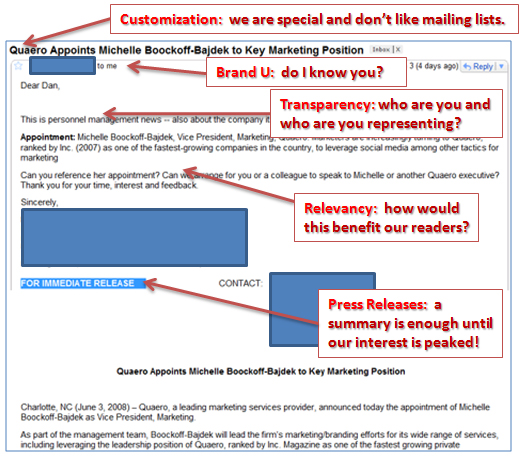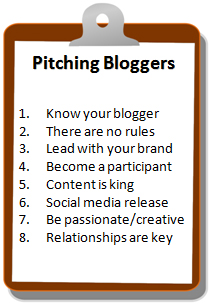Today, anyone can become a member of the media. PR practitioners care wholeheartedly about the blogger population these days, but they tend to treat them like traditional journalists. We shouldn’t be surprised with the sheer amount of press releases that cross wire services, and PR people who flock to bloggers for extra coverage (this especially happens in niche markets). To me, PR has become the supreme way of communicating your personal brand. PR has the power to make you a celebrity or to skip over you to the next expert who has one extra connection or a lot of money (to pay PR firms). In order to become known, the media (blogs/traditional sources) is the way to grow your brand and your business.
PR vs the media
Aside from Chris Anderson’s PR lashings and promotion of PR email addresses, there have been other feuds on the net. Gina Trapani, of Lifehacker fame, has her own blacklist now. Nothing against either of these web celebrities, but I think they need to reconsider posting people’s email addresses and names. I say this because, as I’ve noted before, this information will stay in Google for the duration of people’s lives and possibly tarnish their brand. I use an example below, but hide the person’s information, because my job is to help people instead of punish them. We can learn from mistakes without addressing individuals directly.
There has been a lot of mentions on how PR people are “evil” and how they don’t understand bloggers. There are even blogs called “The Bad Pitch” and “The Good Pitch.” Before we break this topic down anymore, I would like to recommend the top 5 PR agencies that “get it” and the personal brands behind them.
- 1) Edelman – Steve Rubel
- 2) Outcast – Dave Donohue
(disclaimer: they are EMC’s PR Agency) - 3) FutureWorks PR – Brian Solis
- 4) Shift – Todd Defren
- 5) Perkett PR – Jeff Glasson
Bad pitch example

Tips when pitching bloggers
1) Know your blogger. What works for one blogger may not work for another: I’m not sure any blogger has mentioned this tip yet, but feel it’s essential. Since people have individuality, read information differently and have inborn personal preferences, a press release may work for one and a phone call might work for someone else. Some bloggers might enjoy your usage of social media, such as Twitter (Twitpitch) in order to connect with them and share news.
2) Don’t play by the rules because there are no rules. Few bloggers may admit to you that there are actually no rules (at least yet) for distributing content through a blog. If you email a blogger, understand that it may be leveraged for a blog post within the next 5 minutes. In traditional media practices, there are editors and policies, whereas blogs are created by individuals, who don’t have any organizational constraints. Steve Rubel talks about this as well. All you can do is use best practices that are highlighted in this post and the one’s linking from it.
3) Lead with your personal brand. As with everything else we talk about on this blog; you need to introduce yourself by explaining who you are and who you are representing. Ryan Block of Engadget sheds some light on this as well. Brand recognition matters as well. If I already know the person who is pitching me, the probability that I will at least respond is quite high.
4) Become a part of their community. This involves reading their posts, commenting on the posts that you can contribute value or experience to, sharing their posts and linking to their blog. Basically, bloggers love dealing with other bloggers. If you are a PR person, then just having a blog will position you favorably to other bloggers. Darren Rowse has some tips on this as well.
5) Content is king, even with PR pitches. Bloggers enjoy fresh and relevant content, that is unique or special to them. In order to do this, you must customize your pitch to fit their preferences, which you can learn about on their blog. Also, in the subject line of your pitch, use their name. The more effort you put into the strategy behind the pitch and the actually content, the less work we have to do to post it. Lee Odden talks about this in more depth.
6) The social media release. More than anything, I believe in the value of a press release that has “extra component’s” to it. The flat and original release has too much spin and is typically too long. Another issue is that it doesn’t tabulate the conversations around the release and is only consumable in written format. The social media release or SMR uses multimedia elements, such as podcasts and pictures (YouTube/Flickr), embedded hyperlinks, and sharing utilities such as Digg, del.icio.us and Redit. These releases are optimized for the web as well. Here are a few examples. Bloggers appreciate this type of release because there is rich content for their posts.
7) Be passionate and creative. Scott Monty is one of my favorite web 2.0 friends and he blogged about how we was pitched by two people who constructed a video-pitch on YouTube. He enjoyed it so much that he blogged about the pitch, endorsing the product as well.
[youtube=http://www.youtube.com/watch?v=uSd0V5MxdRQ]
8 ) Relationships still trump everything. If you are already friends with the person you are pitching, it becomes less of a pitch and more of a “friendly conversation.” The first question a blogger asks when receiving a pitch is “do I know you”?












